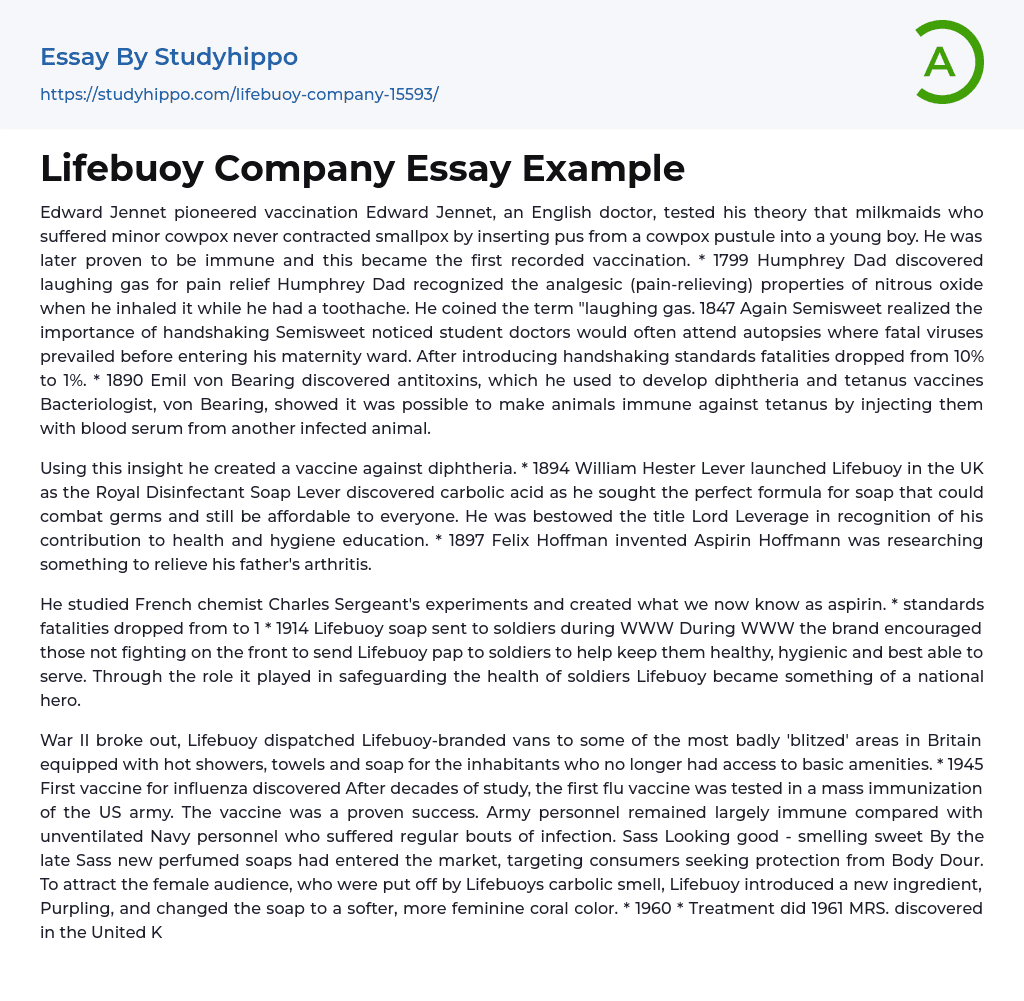Edward Jennet, an English doctor, pioneered vaccination by testing his theory that milkmaids who had contracted cowpox were immune to smallpox. He inserted pus from a cowpox pustule into a young boy, who was later proven to be immune, making this the first recorded vaccination. In 1799, Humphrey Dad discovered the pain-relieving properties of nitrous oxide, which he called "laughing gas," when he inhaled it to relieve a toothache. Semisweet noticed that handshaking standards reduced fatalities in his maternity ward from 10% to 1% after student doctors attended autopsies with fatal viruses. In 1890, Emil von Bearing developed antitoxins and used them to create vaccines for diphtheria and tetanus by injecting animals with blood serum from infected animals. William Hester Lever launched Lifebuoy in the UK as the Royal Disinfectant Soap in 1894 after discovering carbolic
...acid and creating an affordable soap formula to combat germs. Lever was honored with the title Lord Leverage for his contribution to health and hygiene education.In 1897, Felix Hoffman invented Aspirin while researching a solution for his father's arthritis. Inspired by French chemist Charles Sergeant's experiments, Hoffman created what is now known as aspirin. The invention of aspirin led to a significant decrease in fatalities.
During World War I in 1914, Lifebuoy soap was sent to soldiers to promote hygiene and keep them healthy. The brand encouraged those not fighting on the front to send Lifebuoy soap to soldiers. The role Lifebuoy played in safeguarding the soldiers' health made it a national hero. When World War II broke out, Lifebuoy vans were dispatched to heavily impacted areas in Britain. These vans provided hot showers, towels, and soap to the inhabitant
who no longer had access to basic amenities.
In 1945, the first influenza vaccine was discovered after years of study. The vaccine was tested through a mass immunization of the US army and proved to be successful. Army personnel remained largely immune to the flu compared to unvaccinated Navy personnel who suffered from frequent infections.
In the late Sass, new perfumed soaps entered the market targeting consumers seeking protection from body odor. To attract female consumers who were put off by the carbolic smell of Lifebuoy soap, a new ingredient called Purpling was introduced. Additionally, the soap was changed to a softer and more feminine coral color.* 1960 * In the United Kingdom, treatment for MRS. was discovered in 1961. MRS. was the first 'superbug' found to have developed resistance to antibiotics, making it challenging to treat.
Many antibiotics are currently being tested against MRS., but handwashing remains vital for prevention.* 1966 Hand sanitization was invented by Trainee nurse Hernandez, who discovered that alcohol carried in a gel could effectively cleanse germs and bacteria. Initially created for hospital use, it has now become a lifesaving product for mothers everywhere.
- Bankruptcy essays
- Earnings essays
- Tata Group essays
- S corporation essays
- Secretary essays
- Premise essays
- Hospital essays
- Physician essays
- Health Care Provider essays
- Universal Health Care essays
- Readmission essays
- Social Care essays
- Epidemiology essays
- Drug Addiction essays
- Hiv essays
- Hygiene essays
- Obesity essays
- Teenage Pregnancy essays
- Birth Control essays
- Eating Disorders essays
- Causes Of Obesity essays
- Children Obesity essays
- Adidas essays
- Amazon essays
- Apple essays
- Bmw essays
- British Airways essays
- Burger King essays
- Coca-Cola essays
- Company essays
- Costco essays
- Dell essays
- Ebay essays
- Enron essays
- Facebook essays
- Ford Motor Company essays
- Gap essays
- General Motors essays
- Google essays
- Honda essays
- Ibm essays
- Ikea essays
- Intel essays
- Iphone essays
- Johnson and Johnson essays
- Kellogg essays
- Key essays
- Kfc essays
- Mcdonald's essays
- Microsoft essays




